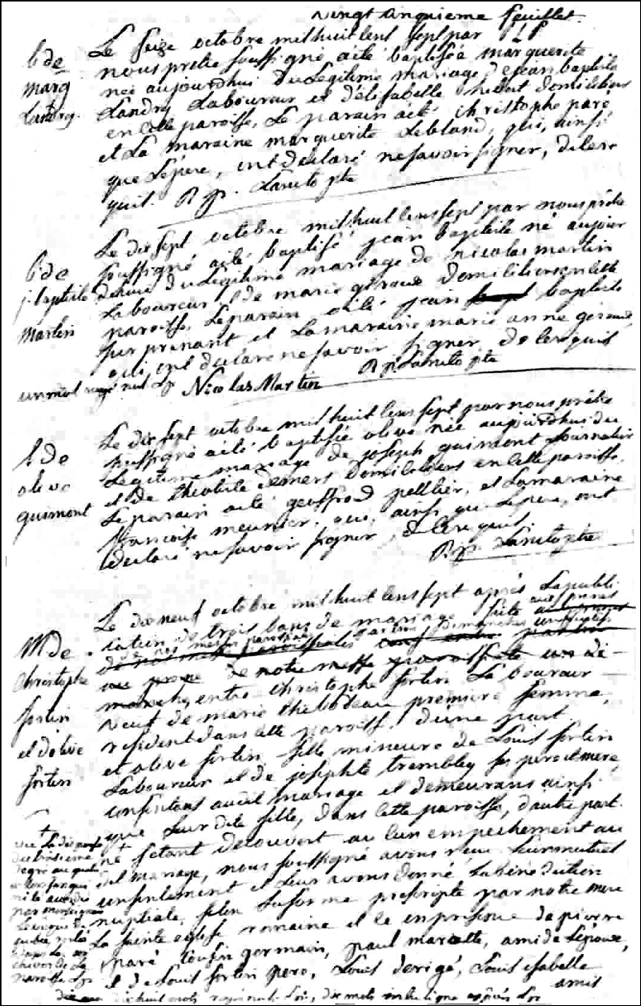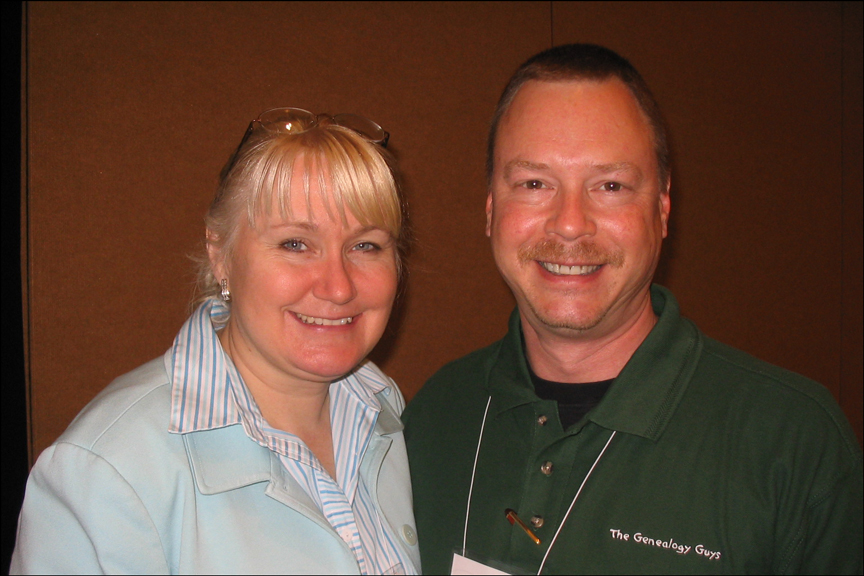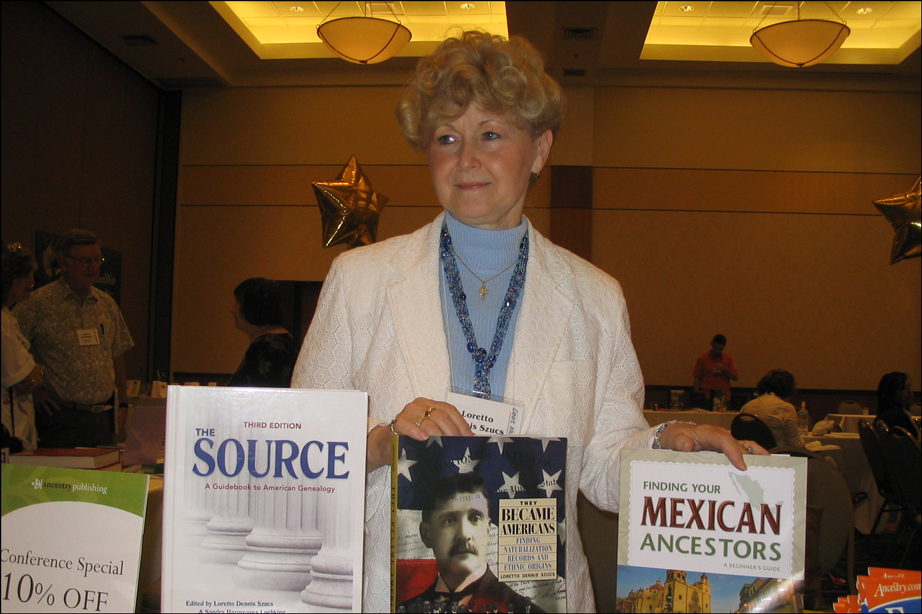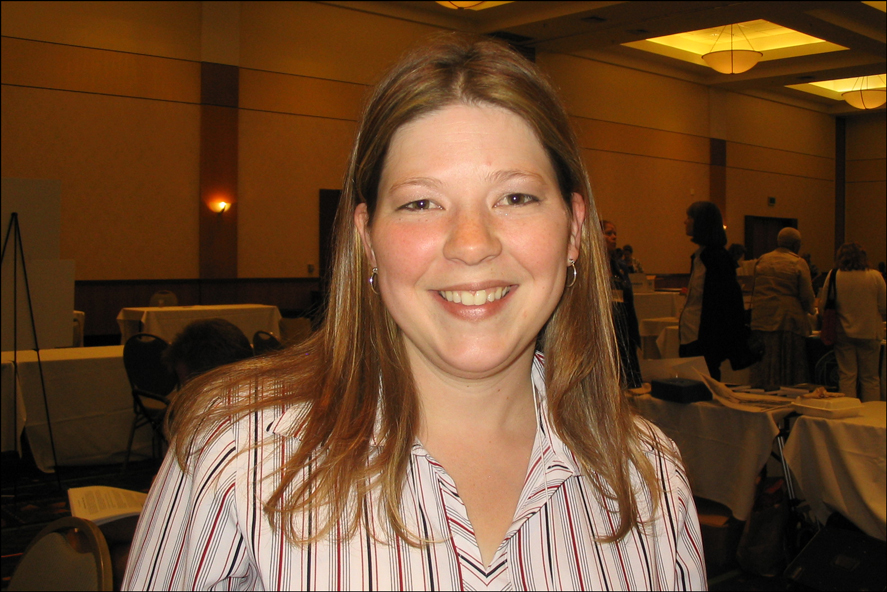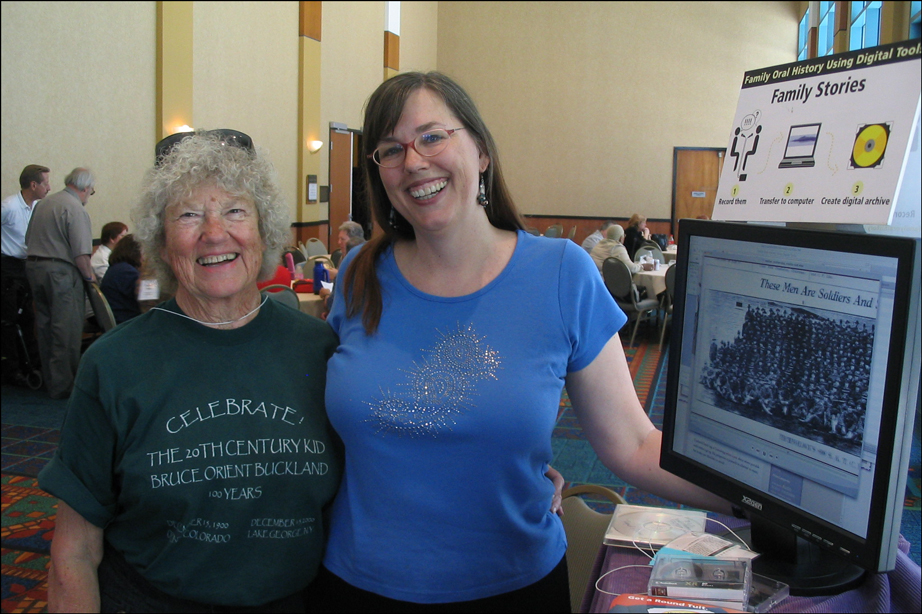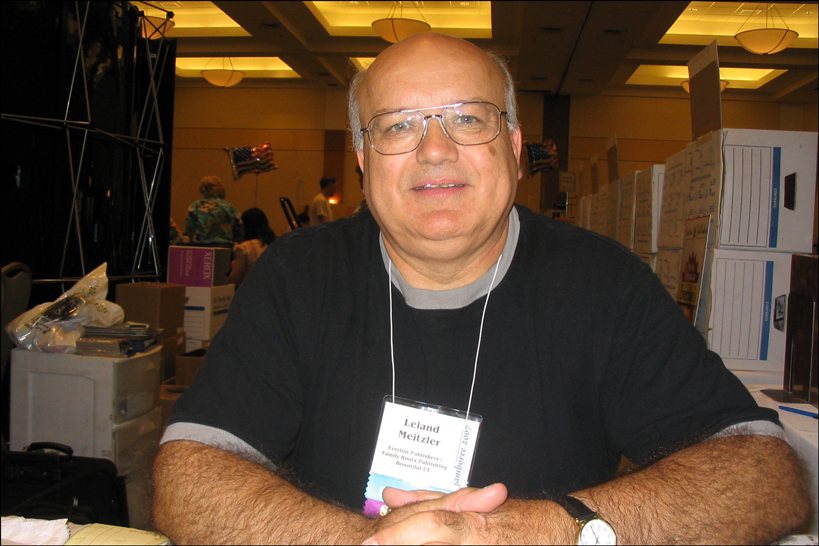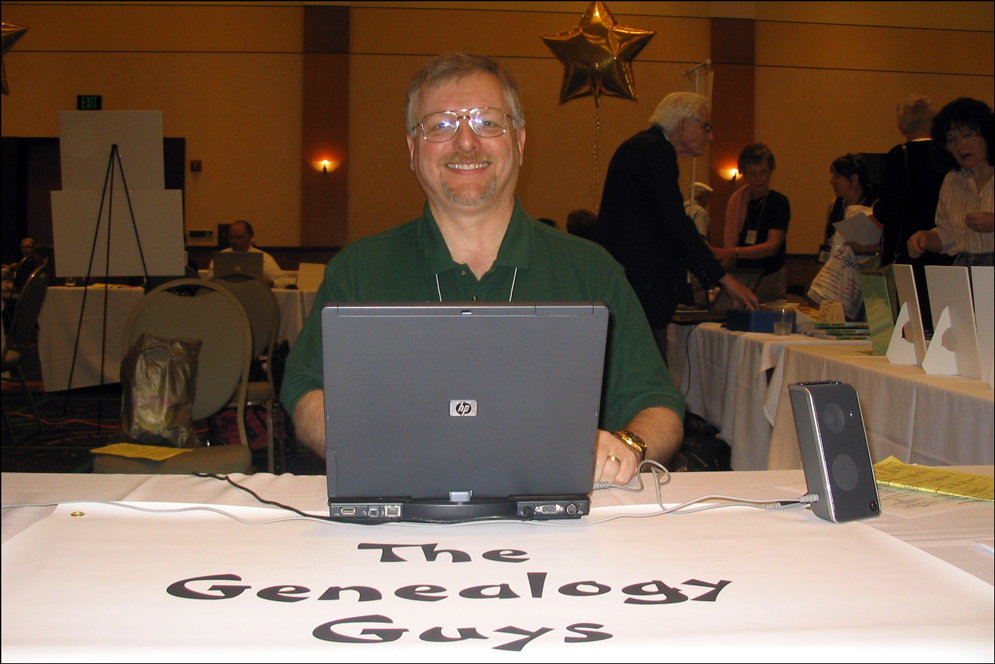The second day of Jamboree 2007 is over, and what a busy day it was! I was up at 6:45 AM to get ready for the first event of the day. I thought I was on vacation this weekend!!??!!
When I registered for Jamboree 2007, I also joined the Southern California Genealogical Society. I suppose that means that this weekend I’m blogging not only for myself, but also for one of the societies to which I belong!
Effective Society Management
The first event this morning was a panel discussion on Effective Society Management over breakfast. Jana Sloan Broglin, Cath Trindle, and Drew Smith answered questions from the audience on Society Management.
The first question asked “How do you find free speakers for your local society?” The panel reminded the audience that you often get what you pay for, although universities, high schools, law firms, local authors, reporters, other local societies in the area, and society members are good sources of local speakers.
Another question was “How do you get people to volunteer”. The panel advised the audience not to beg people to volunteer, but to show members how they are the best choices for the job, make them feel special, ask them what the like to do, and observe those who show up regularly to meetings, since those members are likely to be more reliable than those who don’t regularly attend society functions.
The panel answered several other questions, though space doesn’t allow me to go into more detail here.
Finding Naturalization Records and Ethnic Origins
Lou Szucs began her talk on Finding Naturalization Records and Ethnic Origins by asking if anyone in the audience had witnessed a naturalization ceremony. What did naturalization mean to those being naturalized? Often, naturalization is an emotional event for those becoming citizens.
The biggest problem in finding naturalization records is finding the court in which the records are maintained. Often, the Certificate of Citizenship was very valuable to the naturalized citizen and may have survived through the years in the hands of family members.
Declarations of Intention and Petitions for Naturalization have been microfilmed for some courts throughout the country. The microfilms may be found in the Family History Library or in State Archives. In some areas, the Works Progress Administration (WPA) indexed the naturalization records.
Lou, who lives in the Chicago area, described an example of where the original naturalization records burned in the Great Chicago fire. In that case, she found a document where an applicant reregistered for naturalization, stating “Through no fault of mine, the city of Chicago burned…”
Sometimes, religious records can provide clues to the ethnic origins of ancestors. In one example, Lou explained how she researched an ancestor in the religious records, didn’t find the person for who she searched, but she found records for the siblings of the individual. Using those records, she was able to trace the ancestor to Ireland, and was able to trace the family back further in time using Griffith’s Valuation.
2007 Update on the Use of DNA in Tracing Your Ancestry
Bennett Greenspan, president of Family Tree DNA, discussed the latest information on Tracing Ancestry Using DNA.
Using markers on the Y chromosome, men can trace their paternal ancestry (father-to-father-to-father-etc) directly. Using mitochondrial DNA markers, both men and women can trace their maternal ancestry (mother-to-mother-to-mother-etc).
Family Tree DNA has over 4000 surname projects and hundreds of geographic projects. Each participant can join up to 6 projects. As long as people have signed releases, participants receive reports showing the names and addresses of those people whose DNA matches their own.
Y DNA can point you in the direction of your ancestral migratory path. Mitochondrial DNA results can also point you in the direction of your ancestral migratory path, but also provide evidence for deep relationships or haplogroups.
Family Tree DNA has a relationship with National Geographic. Family Tree DNA has sold 93,000 test kits directly, and National Geographic has sold 208,000 test kits.
Hanging Y Chromosome Data on Your Family Tree
Diahan Southard, a molecular biologist with Relative Genetics, presented a cogent talk on using Y chromosomal DNA in genealogical research.
Diahan showed how analysis of Y chromosomal DNA can be used to sort out questionable family relationships. In particular, she showed how analysis of Y DNA enabled Relative Genetics to sort out family relationships in the Ethington family.
A four step process was used to understand these relationships, using the DNA analysis of several family members.
- Evaluate the data table. To determine if two individuals hare a common ancestor, simply count how many times the two individuals have different values for the same marker.
- Visualize the results with a cladogram (haplocation diagram). A cladogram first separates the group of individuals into genetic lineages that includes individuals with no more than four differences from anyone else in the group. For each lineage determine the most common allele at each marker – this is the modal haplotype. Represent each lineage with a circle and connect lineages (circles) with lines to represent a single difference between two lineages.
- Find the Most Recent Common Ancestor (MRCA) by carefully analyzing the mutations observed among the individuals in the study.
- Compare the genetics data with the genealogical data to determine if the family relationships derived by traditional genealogy are correct.
This is certainly a difficult concept to describe in a limited amount of space here, but it was astonishing to see how analysis of the DNA of a number of individuals who are theoretically related can clearly identify relationships (or lack thereof) even if the traditional genealogical records are ambiguous or conflicting.
Genealogy Resources in the California History Room
Catherine Hanson-Tracy described the Genealogy Resources in the California History Room at the California State Library in Sacramento.
The California State Library has an online catalog that includes a number of genealogically relevant resources including:
- Books: County and local histories, biographies, diaries, guidebooks, cookbooks, novels, business and institutional histories.
- Newspapers: 1846 to the present, more than 2200 titles, at least one major newspaper from every county, over 140,000 microfilm reels.
- Magazines and Journals: more than 4,000 titles, 1856 to the present, scholarly and popular, historical society periodicals.
- Maps: more than 5,000 items, originals and microfiche copies, early city and county maps, Sanborn Fire Insurance Maps.
- Manuscripts: Personal correspondence, organization records, business records, more than 700 processed collections.
- Pictorial Resources: Over 125,000 photographs, albums, and portfolios, postcards, letter sheets, lithographs, online picture catalog (with an emphasis on Southern California), and a lot of stereographs.
- Ephemera: Posters, promotional brochures, menus, campaign literature, advertisements. Print-on-demand copies of some of these ephemera can be obtained through Zazzle.com.
- Unique Indexes and Files: California Information File, San Francisco Newspaper Index, Biographical Card File, Biographical Information File.
- Directories: City Directories as early as the 1850s, Telephone Directories 1899- Present, originals and microfilm copies.
- Great Registers of Voters: 1866-1944, providing name, address, age, occupation of voters, arranged by county.
- Vital Records Indexes: California marriage and death indexes, Nevada marriage and divorce indexes.
- Census Records: California Federal Census Records, California State Census Records for 1852.
The location of the library is 900 N Street, Room 200, Sacramento, CA. The library is open Monday through Friday, 9:30 AM – 4 PM.
The California State Library supports Research at a Distance with an online catalog, website, online archive, interlibrary loan, and assistance by email or phone.
The California Gold Rush
I have little knowledge of the California Gold Rush, and I’ve never found any connection of the California Gold Rush with my family history. Nonetheless, I decided to attend this lecture by Chuck Knuthson to provide myself with some background on the Gold Rush, primarily to learn more of the local history (I didn’t grow up in California, so even though I’ve lived here for 18 years, my knowledge of local and state history is woefully lacking).
In 1769, California’s first Mission and Presidio were established in San Diego.
For 200 years Europeans thought California was an island, and most early inhabitants arrived by sea.
In 1846, the United States declared war on Mexico, a war that ended in February 1848, shortly after gold was discovered in California. Mexico ceded more than half its territory, including California, to the United States.
In 1850, California achieved statehood and, notably, entered the union as a free state, rather than a slave state.
On 24 Jan 1848, James Marshall was building a sawmill on the American River for John Sutter, and discovered gold at Cullumah (now Coloma). In May 1848, a merchant named Samuel Brannan stocked up his store with mining supplies, and then ran through the streets of San Francisco waving a bottle of gold dust and crying, “Gold! Gold! Gold from the American River!” By the summer of that year, there were 2,000 miners at Coloma, and by 1849 there were 10,000 miners.
Early prospectors were called “Forty-Niners” because they arrived in California in 1849. In 1850, 90% of the people in California were men.
When researching records from the Gold Rush, one should apply the same techniques as one generally applies to American Records, tracing ancestry from the present to the past. Some records specific to the Gold Rush include Mining Claims (sometimes called Placer and Quartz Claims), water rights, and mineral rights.
Footnote.com
In the evening, I attended an update on Footnote.com hosted by Beau Sharbrough.
Beau gave a tour of the Footnote.com website, reviewing the organization of the site, the content provided, and the plans for the future.
To be brief here (it’s getting very late and I have to be up again at 6:45 AM), I was impressed by the ambitious goals for Footnote.com and look forward to seeing new content in the coming months.
One clear advantage of the subscription structure Footnote.com has established is that one can examine a low resolution image and the metadata for the image without subscribing. One can purchase a single image at a time, a monthly subscription to all images, or an annual subscription to all images. This pricing structure means that you don’t have to purchase anything until you know there is a document of interest, and you don’t have to commit to a long subscription term.
Look for great new content on Footnote.com in the coming months!
Copyright © 2007 by Stephen J. Danko

